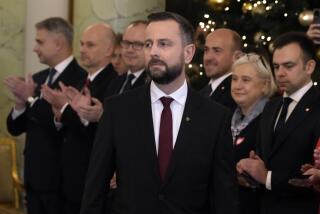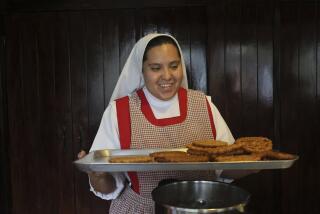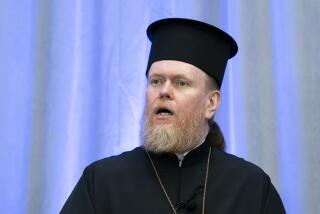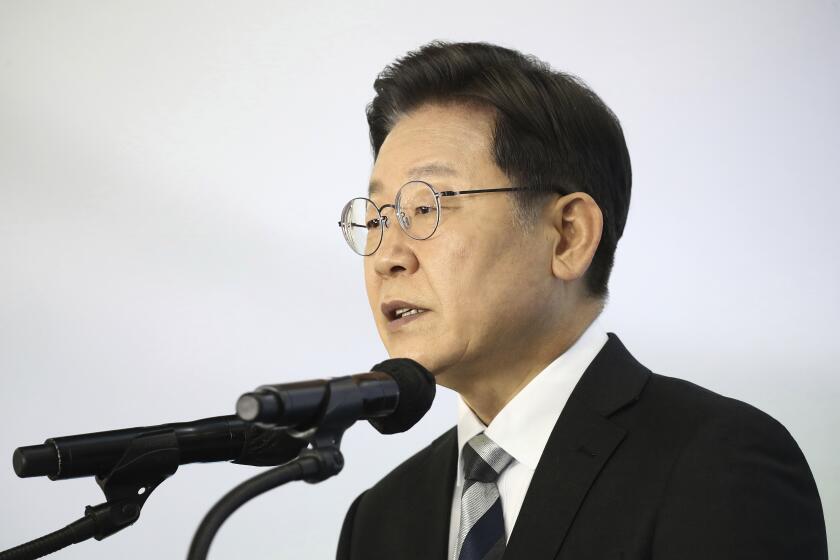Priesthood in Poland Draws Added Novices Amid Losses Elsewhere : Catholic church: Burundi, Rwanda, Zaire and India are the only other countries with net increases of seminary students in recent years.
- Share via
WARSAW, Poland — It is peaceful in the seminary, as it was through times of partition, before the Communists and after they fell, and when rigid economics was left behind on the bumpy road to a free market.
The only sounds reaching the office are the gentle swish of long black robes as priests glide across the marble floor in sandals, and the chirping of swallows that inhabit lush inner courtyards thick with ferns, red petunias and lavender geraniums.
Priestly routine in Poland, one of only five countries where the number of Roman Catholic seminary students has risen steadily during the last decade, bears little resemblance to the difficult, uncertain life on the outside.
While the church generally faces a chronic shortage of priests, the number in this country rose from 20,234 in 1980 to 24,678 in 1989, according to the Polish Episcopate Office.
That works out to one priest for 1,280 church members, compared with 1,650 members per priest in the United States.
Burundi, Rwanda, Zaire and India are the only other countries with net increases in recent years.
Church officials give many reasons young men are attracted to the priesthood in Poland, where more than 90% of the people are Catholic. Most obvious is a desire to follow the path of the Polish Pope, John Paul II, whose image is displayed over shop doors, in cars, even on key chains.
“John Paul is beloved everywhere, but especially here,” said Father Szymon Stefanowicz of the Jasna Gora monastery in Czestochowa, site of Poland’s holiest shrine. “Is it any wonder young men want to be like him? He is such a good force in this world.”
Being a priest is a mark of prestige in Poland. Enrollment of a son in the seminary is as much a cause for celebration as an American child’s acceptance into law or medical school.
Although church officials stress the compulsion to answer God’s call, some acknowledge the attraction also may be practical.
Since World War II, families have had to wait decades for apartments, telephones and cars. Until the economic reforms of January, they had to spend hours in line for such essentials as milk and eggs.
In contrast, seminaries offered secure housing, intellectual opportunities and a chance to travel outside the Soviet Bloc.
Several priests, who spoke on condition of anonymity, said seminaries were havens of safety and comparative comfort through the bad times.
Outside, the dangers of communist rule now have been replaced by painful aspects of the “shock therapy” economic plan.
Inflation is more than 170% so far this year, and unemployment, unknown under the Communists, has reached 4%.
“In the West, children are born with everything: television, computers and cars,” said Brother Marian Laskowski, a 24-year-old monk from Elblag in northern Poland. “In Poland, we are born with very little.”
Laskowski said he chose the seminary because he is drawn to God, but he admitted to occasional doubts.
“I see people come here wearing short sleeves and short pants, and I am spending the best years of my life between these cold marble walls,” he said. The monk, dressed in a heavy robe, was tending a stand at St. John’s Cathedral in Warsaw that sells icons and religious postcards.
Brother Maciek Gaup, also 24, said his decision was made at an early age. “Poland is a very spiritual country,” he said. “Our religion is very, very strong and old.”
In the Soviet Union, those who worshiped openly faced persecution, and the Orthodox Church was strictly controlled. In Poland, the church withstood the repression and became a powerful rival of the regime.
During martial law in 1981-83, the pulpit was a bastion of dissent. Father Jerzy Popieluszko, the “Solidarity priest” murdered by secret policemen in 1984, is revered as a martyr.
Worshipers fill churches each Sunday. Construction of religious buildings in many predominantly Catholic countries has all but stopped, but nearly 1,000 churches and other religious buildings have been erected in Poland since 1985.
Father Henryk Kietlinski, deputy superior of the Pallotines, one of the country’s most popular religious orders, interviews hundreds of young men who apply for admission to its seminary each year.
“Many of them are very excited about passing on the pastoral word in today’s world,” he said. “Others want to give service to the world, and others are excited about the possibility of missionary work in other countries.”
Poland is one of the few countries with enough priests to send some of them abroad.
Travel by priests was almost unrestricted under the Communists, but they made it extremely difficult for most other Poles to venture outside the Soviet Bloc.
Now that Poland is democratic, a goal the church helped achieve, some Catholic officials fear that growing Western influence will deter young men from the priesthood.
Records and videos of Madonna, whose Catholic allusions the church calls blasphemous, are bestsellers. Sex shops and pornography, once taboo, are cropping up in all but the smallest villages.
More to Read
Sign up for Essential California
The most important California stories and recommendations in your inbox every morning.
You may occasionally receive promotional content from the Los Angeles Times.










